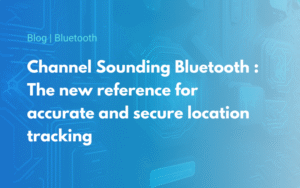iBeacon is a wireless communication technology used in the Internet of Things (IoT), and the market is growing rapidly. According to a report by MarketQuest.biz, the iBeacon market is expected to reach USD 109,532 million by 2027. Often known for its usefulness in targeted marketing strategies, this technology is also being developed by manufacturers.
This article will allow you to understand what iBeacon is, from its origin to how it works and its applications.
What is iBeacon?
iBeacon, a wireless communication technology
iBeacon is a standardised BLE frame format defined by Apple to facilitate the integration of BLE beacons into iOS applications. With this protocol, mobile applications can simply and securely receive and use the data generated by iBeacons. A large number of applications have already been created using the ‘Point of Interest’ function, in which the application triggers a predefined action when the phone comes within range of a beacon.
This function is particularly popular in marketing, as it attracts and appeals to customers in a different and original way.

An Apple innovation
iBeacon was introduced at Apple’s developer conference in June 2013 to make Bluetooth Low Energy beacons interoperable with iOS. It went live with iOS version 7, creating a craze for this communication protocol.
Indeed, iBeacon was initially driven by iOS application developers. Its ease of integration led to the development and marketing of numerous use cases and corresponding products. This largely contributed to the explosion of Bluetooth Low Energy technology compared with its main competitors (Zigbee, Z-Wave, etc.). In a snowball effect, traditional beacon manufacturers integrated the iBeacon format as standard and began to offer professional IoT solutions for businesses using the same format.
iBeacon, Android & iOS
Developed by Apple, the iBeacon protocol is initially optimised for the iOS operating system, but also works on Android devices. Since this protocol uses Bluetooth 4.0 technology, it is compatible with all smartphones equipped with a Bluetooth chip.
How does iBeacon work?
As we said in the introduction, iBeacon is very often used in consumer marketing campaigns, but it is also developing in more industrial fields. To better understand the mechanics of IoT solutions based on this technology, here’s an initial look at how it works technically.
How iBeacon works technically
The technical operation of iBeacon is based on an architecture made up of 3 main elements: a transmitter, a receiver and a back-end.
- The transmitter is a connected object known as a ‘beacon’, based on Bluetooth wireless communication technology embedding the iBeacon frame.
- The receiver, for example, is an iOS or Android smartphone or tablet equipped with Bluetooth, on which an application (from a shop or brand, for example) using iBeacon technology will be installed.
- A back-end that will transmit an object, a URL or a command in response to the iBeacon data collected. This back-end can be integrated into the application or hosted on a cloud server, for example.

The iBeacon standard contains 3 pieces of information to identify the beacon: a general identifier called UUID (16 bytes long), an identifier corresponding to the group of beacons (sign location) called ‘major’ and finally the beacon’s own identifier called ‘minor’ to differentiate it from other nearby transmitters.
iBeacon also contains information about the transmission power of the BLE signal. By measuring the power of the signal (RSSI) received, it is possible to estimate the distance between the transmitter and the receiver.
As with other advertising communication technologies, iBeacon requires the approval of the end user in order to work. In order for the end user to receive the notifications sent by the retailer, the following points must be met:
- The customer must have the company/brand application.
- Bluetooth must be activated on your smartphone.
- Push notifications must be authorised.
Use case
As mentioned earlier in this article, iBeacon technology is used by companies as part of their one-to-one marketing strategy. This involves tailoring marketing promotions and communications to the expectations and profile of each customer. By being compatible with all Bluetooth-equipped smartphones, iBeacon can be used to push out a number of personalised items of information, such as :
- Promotional offers
- Product or service information
- Information on the customer’s position
- Etc.
This wireless communication technology is used in a wide range of sectors, including retail, banking, airports, entertainment and industry. We take a look at 3 of these sectors: retail, entertainment and airports.
Retail:
In retail, iBeacon is often used in shopping centres and supermarkets. For shops, iBeacon is an effective way of sending a notification to customers entering the shop via the brand’s mobile application previously installed on their phone. Thanks to precise geolocation, customers can receive offers relating to their location, such as fashion advice, a promotional push or product recommendations. For shop staff, iBeacon is useful for notifying customers when they arrive at a shop that has the application installed.
Entertainment:
In the field of entertainment, iBeacon can be used in museums to enhance the visitor experience. Museums with a mobile application can provide information about works of art based on the visitor’s location. This also enables visitors to find their way around the museum and be informed of the various services available nearby (restaurants, toilets, points of interest, etc.).
Airports:
It is often difficult for travellers to find their way around airports, which causes a lot of stress. The iBeacon is a very useful technology that allows users to locate themselves in the airport, find the concourse corresponding to their flight and access the various services nearby.
For businesses in all sectors, iBeacon is an excellent tool for considerably improving the customer experience by offering personalised communication. This technology enables companies to collect a wealth of behavioural data about their customers, creating a link between physical shops and digital tools.
Would you like to find out more about this technology so that you can integrate it into your tools?
As ELA Innovation beacons are compatible with iBeacon technology, we invite you to contact our experts to discuss your IoT project.
iBeacon vs Eddystone
Eddystone, a beacon format developed by Google, is a competing technology to iBeacon in the field of BLE communication. Although they share similar technical foundations, their approach and flexibility differ. Whereas iBeacon is centred on the Apple and iOS ecosystem, Eddystone is more open and multiplatform, natively compatible with Android and easier to integrate into third-party systems. Eddystone stands out for its ability to broadcast several types of frame, such as URLs (Eddystone-URL) or telemetry information, making it more flexible for IoT or context-sensitive applications. The iBeacon, on the other hand, is often favoured for its ease of integration into commercial applications, particularly for targeted marketing campaigns. The choice between the two therefore depends on specific needs in terms of ecosystem, flexibility and the applications envisaged. Find out more about the Eddystone protocol


